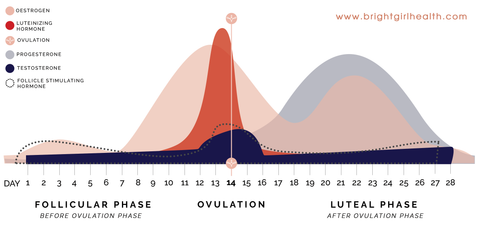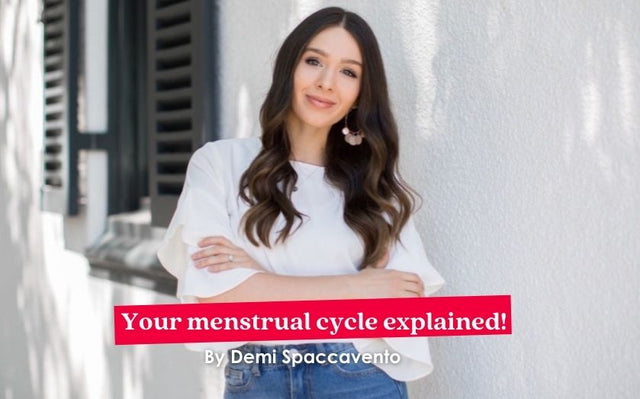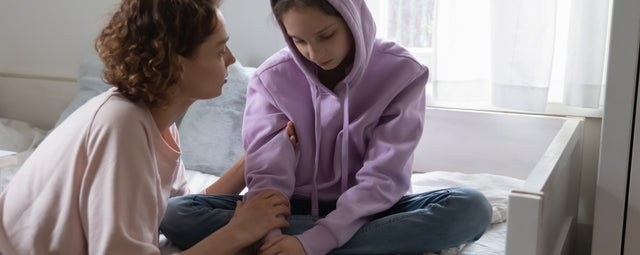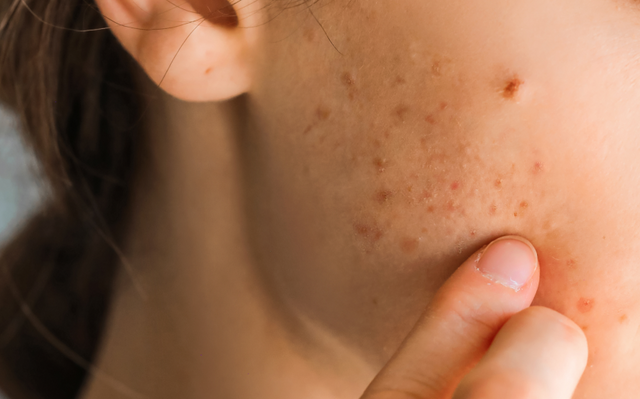Here at Modibodi we care.
Your menstrual cycle is not just about your period bleed. In fact, your period bleed is only a small part of the menstrual cycle. There are other cycle phases to be aware of.
Demi Spaccavento is a passionate women's health educator, author and high school teacher - she has no filter when it comes to talking about periods and believes that we should never be kept in the dark about our own bodies. She believes that the menstrual cycle does not have to be your enemy - it can be your greatest tool for better health and wellbeing! We've asked her to guide us through the 4 phases of the menstrual cycle to educate us and help us feel empowered.

If you have a period, then on any given day you are in one phase or another of the menstrual cycle.
There are 4 menstrual cycle phases. They are:
- The menstrual phase (your period)
- The follicular phase OR ‘before ovulation’ phase
- The ovulation phase (ovulation is when an ovary releases an egg)
- The luteal phase OR ‘after ovulation’ phase
How we feel physically, mentally and emotionally in each phase can be very different. This is because our hormone levels in each phase of our cycle are different.
Have you ever felt like one week you’re happy, enjoying life, able to concentrate on work or study, feeling super confident and social… and then the next week you just want to couch it up and watch Netflix all day? Each week of our cycle our hormones change significantly, and this can be reflected in our moods, behaviours, and physical symptoms.
Knowing which cycle phase we are in can help us to work with these changes, rather than having these changes control our life or impact us negatively.
HORMONES THROUGHOUT THE MENSTRUAL CYCLE

THE MENSTRUAL PHASE:
When your period bleed starts, this is day 1 of the menstrual cycle. We usually bleed for 4-7 days, and this is the menstrual phase.
I call this phase the ‘sloth phase’ as we can tend to feel a little slower and sleepier like a sloth.
What we might experience while in our menstrual phase:
- Bleeding for 4-7 days (this is the average)
- May experience menstrual cramps (not everyone does!)
- May feel tired, slow, tearful or more inward focussed
- May experience food cravings
- May experience leg pain, back pain or headaches
- May experience PMS symptoms go away when your period starts
- Some people may even feel an increase of energy
- Some people experience the more severe period symptoms such as migraines, fainting or vomiting
What are our hormones doing?
In order to signal our period to begin, our reproductive hormones, oestrogen and progesterone, drop very low.
THE FOLLICULAR PHASE:
The follicular phase (or ‘before ovulation’ phase) is the time between the beginning of your cycle (day 1 of your period) and ovulation. However, we usually focus on the follicular phase as the time between when your period bleed ends and ovulation.
The follicular phase can vary in length from person to person. People with a long menstrual cycle (e.g. someone who gets their period only once every 2 months) will have a much longer follicular phase than someone who menstruates every 28 days.
I call this phase the ‘lioness phase’ because lioness’ are hunters, and in this phase we can tend to feel stronger and more energetic.
What we might experience while in our follicular phase:
- Menstruation stops
- May feel more energetic and strong
- May experience an increase in concentration levels and brain function - a great time to be productive
- May have stable moods and eating behaviours
- May be able to perform best in sports/exercise
- May feel more social and confident
- Your body is preparing for ovulation to happen, and your ovaries are maturing an egg to be released
We start to see an increase in cervical fluid and a change in its consistency to become more wet. This happens towards the end of the follicular phase as ovulation is approaching (cervical fluid is mucous made by the cervix and can be observed on your underwear or on toilet paper after wiping).
What are our hormones doing?
The hormone Oestrogen is rising, which thickens up the lining of our uterus and helps mature an egg to be ovulated.
Towards the end of the follicular phase, testosterone increases slightly, giving us increased energy.
Progesterone is extremely low.
THE OVULATION PHASE:
Ovulation is a very short phase, as once an egg is ovulated (released from one of our ovaries) it only lives for around 12-24 hours. The ovulation phase is roughly 1-3 days surrounding the time an egg is released. This only happens once per menstrual cycle.
I call this phase the ‘peacock phase’ because peacocks spread their feathers when trying to attract a mate, and ovulation is the time in humans when pregnancy occurs. And in case you’re wondering, no - pregnancy is NOT possible on every single day of your cycle. Sexual intercourse can only lead to pregnancy roughly 5 day before ovulation and 2 days after.
When does ovulation happen?
Ovulation happens on a different day in our cycle for everyone. We often hear that it happens on day 14, however, we’re not all robots or clones, and the timing of ovulation can differ.
Late ovulation usually results in a late period.
Early ovulation usually results in an early period.
If ovulation doesn’t happen, this can lead to a missing period.
What we might experience while in our ovulation phase:
- May feel more energetic and strong
- May experience increased libido and confidence
- May experience an increase in concentration levels and brain function - a great time to be productive
- May have stable moods and eating behaviours
- May be able to perform best in sports/exercise
- May feel more social and confident
- Some people also experience ovulation spotting - a small amount of bleeding at ovulation time (this can indicate a hormone imbalance)
- Some people also experience ovulation pain - pain similar to period pain but at ovulation time (this can indicate a hormone imbalance)
- Some people may also experience other ovulation symptoms such as headaches
We start to see an increase in cervical fluid and a change in its consistency to become more wet. This happens towards the end of the follicular phase as ovulation is approaching (cervical fluid is mucous made by the cervix and can be observed on your underwear or on toilet paper after wiping).
What are our hormones doing?
Oestrogen peaks just before ovulation in order to trigger a hormone called LH (luteinising hormone) to spike. This LH spike causes ovulation to happen.
Testosterone is at its peak but will decline shortly after ovulation.
Progesterone begins to be made by the follicle on our ovary from which the egg was ovulated. This is called the corpus luteum.
THE LUTEAL PHASE:
The luteal phase (or ‘after ovulation’ phase) is the time between ovulation and before the start of menstruation, when the body prepares for a possible pregnancy. Progesterone is produced, peaks, and then drops.
I call the ‘cat phase’ because cats can cuddle you one minute and hiss at you the next - tell me that doesn’t sound like PMS! This is the phase when we experience PMS (premenstrual syndrome) symptoms.
The luteal phase usually ranges from 11-18 days in length, but is commonly closer to 14 days. Most people have a luteal phase length that is ‘typical’ for them, and it usually doesn’t vary much from month to month.
Because the luteal phase is usually between 11-18 days in length, that means your period will arrive 11-18 days after ovulation (but usually closer to 14 days).
Here is what we might experience while in our luteal phase:
- PMS symptoms (acne, mood swings, tearfulness, leg/back pain, headaches, etc.)
- Breast tenderness and lumpiness is common in this phase, but should resolve once your period arrives
- May experience decreased energy
- May experience decreased concentration levels
- May experience an increase in feelings of anxiety and depression
- A decrease in the wetter cervical fluid we experience at ovulation time. We still might see cervical fluid in this phase but it won’t be as wet/slippery as in the ovulation phase
- Basal body temperature (temperature taken first thing in the morning) increases in the phase. If tracking basal body temperature, you will see an increase in morning temperature due to an increase in the hormone progesterone in the luteal phase
What are our hormones doing?
Oestrogen should be lower than other phases.
Progesterone takes over from oestrogen to maintain the uterine lining. A good balance between oestrogen and progesterone should mean minimal PMS symptoms. Imbalance between these 2 hormones increases PMS symptoms.
Testosterone is very low again.
USE THESE PHASES TO YOUR ADVANTAGE!
You will feel different in each phase of your cycle because of shifts in hormone levels in each phase.
Now that you know this - use it as your superpower!
You now know how to expect to feel and so you are better equipped to support your body with what it needs in each phase.
In phases where you’re feeling good - take advantage of it.
In phases where you’re more tired, take more time to rest and practice self-care. Most importantly, remember that this phase won’t last forever!

You can learn more about this in Demi's book - The Bright Girl Guide, or follow her:
Instagram: @brightgirlhealth
Facebook: www.facebook.com/brightgirlhealth
References:
Trickey, R. (2011). Women, Hormones and the Menstrual cycle (3rd ed.). Victoria, Australia: Trickey Enterprises.
Weschler, T. (2015). Taking Charge of Your Fertility: The Definitive Guide to Natural Birth Control, Pregnancy Achievement, and Reproductive Health (20th Anniversary edition). Harper Collins.
Rao, K.A. (2009). Textbook of Gynaecology (1st ed.). India: Elsevier.
Sundström Poromaa, I., & Gingnell, M. (2014). Menstrual cycle influence on cognitive function and emotion processing-from a reproductive perspective. Frontiers in neuroscience, 8, 380. https://doi.org/10.3389/fnins.2014.00380
OpenStax. (2013). Anatomy and Physiology. Houston, TX: OpenStax CNX. Retrieved from https://opentextbc.ca/anatomyandphysiology
Bigelow, J., Dunson, DB., Stanford, JB., Ecochard, R., Gnoth, C., & Colombo, B. (2004). Mucus observations in the fertile window: a better predictor of conception than timing of intercourse. Human Reproduction. 19(4), 889-892. doi: 10.1093/humrep/deh173.






